A Comprehensive Report on the Advantages of IPv6 Over IPv4 Protocols
VerifiedAdded on 2022/12/27
|11
|2266
|31
Report
AI Summary
This report provides a comparative analysis of Internet Protocol versions 4 and 6 (IPv4 and IPv6), emphasizing IPv6's superiority. It begins with an executive summary and introduction, outlining the core differences between the two protocols. The report delves into key features such as address space, where IPv6's significantly larger address space is highlighted as a major advantage. It also examines the mechanisms of transition from IPv4 to IPv6, functionalities, and the issue of incompatibility. The report discusses the enhanced security features of IPv6, including encryption and authentication, which offer better protection compared to IPv4. Furthermore, it explores the impact of IPv6 on network performance, including the efficiency of data transfer and the simplification of processes. The report also touches upon congestion control mechanisms, such as the Datagram Congestion Control Protocol (DCCP) and Transmission Control Protocol (TCP), and how they are implemented in both IPv4 and IPv6. In conclusion, the report underscores IPv6's advantages in terms of security, address space, and performance, positioning it as the preferred choice for future internet protocols. Finally, it references various research papers and patents to support its claims.
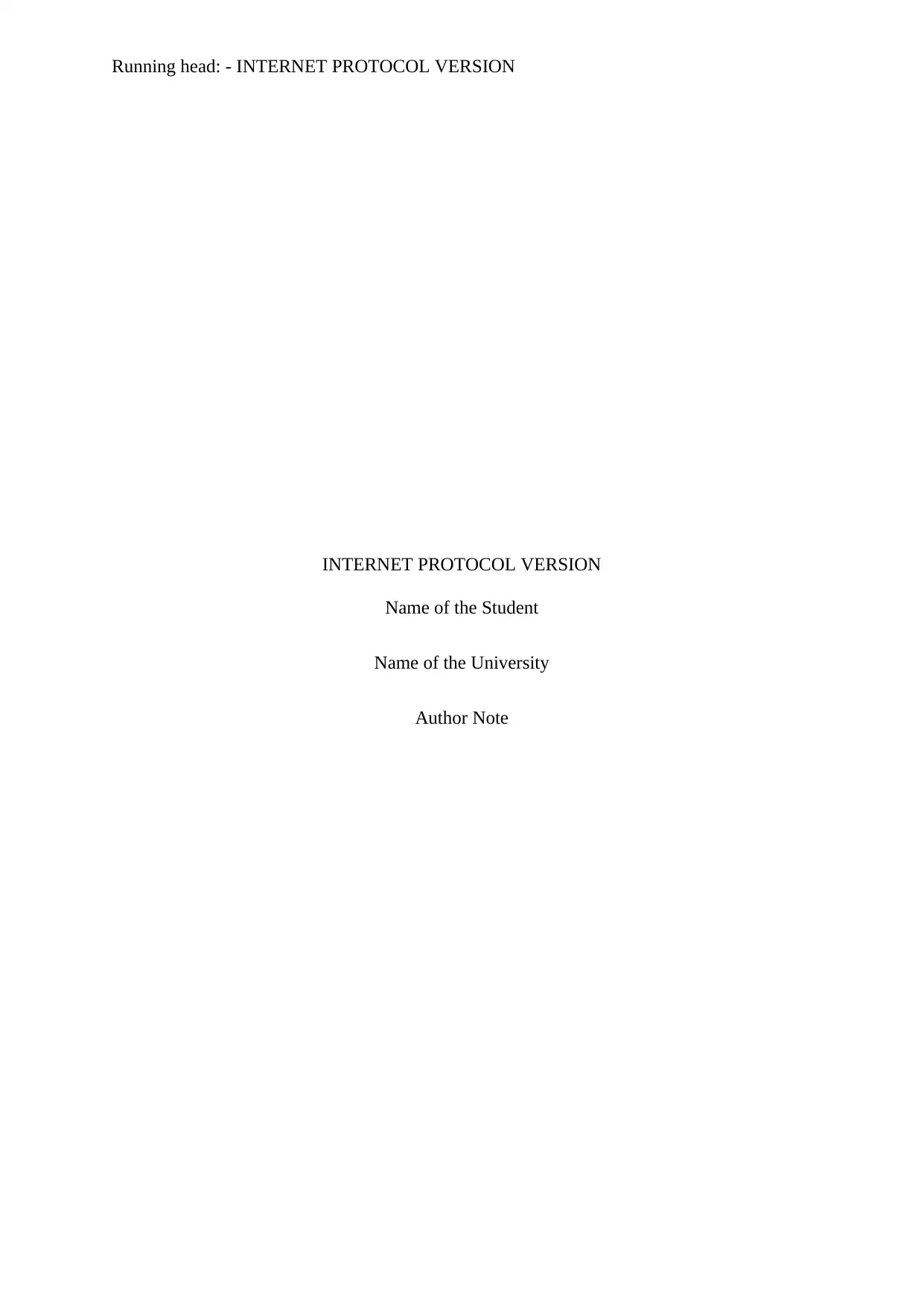
Running head: - INTERNET PROTOCOL VERSION
INTERNET PROTOCOL VERSION
Name of the Student
Name of the University
Author Note
INTERNET PROTOCOL VERSION
Name of the Student
Name of the University
Author Note
Paraphrase This Document
Need a fresh take? Get an instant paraphrase of this document with our AI Paraphraser
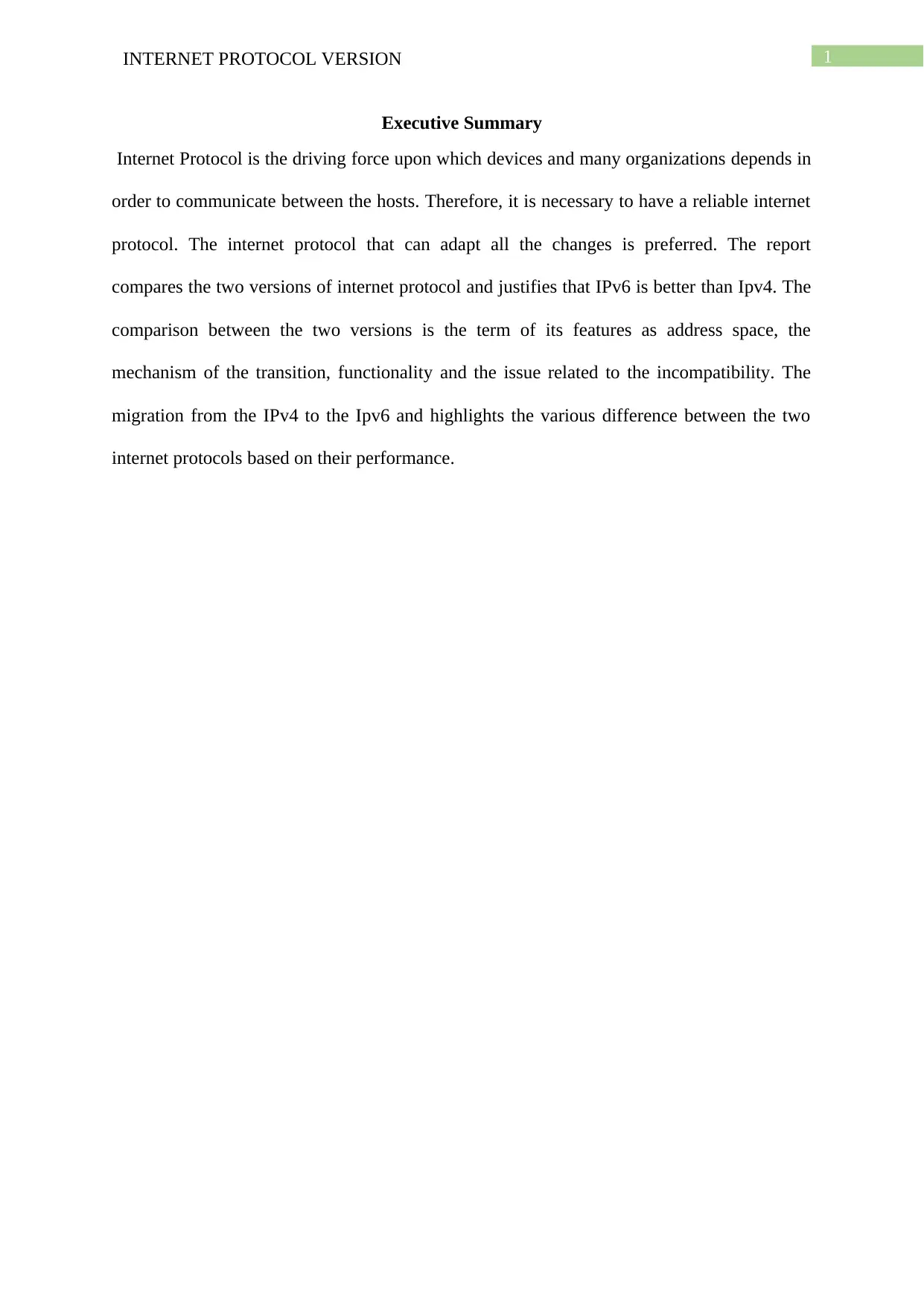
1INTERNET PROTOCOL VERSION
Executive Summary
Internet Protocol is the driving force upon which devices and many organizations depends in
order to communicate between the hosts. Therefore, it is necessary to have a reliable internet
protocol. The internet protocol that can adapt all the changes is preferred. The report
compares the two versions of internet protocol and justifies that IPv6 is better than Ipv4. The
comparison between the two versions is the term of its features as address space, the
mechanism of the transition, functionality and the issue related to the incompatibility. The
migration from the IPv4 to the Ipv6 and highlights the various difference between the two
internet protocols based on their performance.
Executive Summary
Internet Protocol is the driving force upon which devices and many organizations depends in
order to communicate between the hosts. Therefore, it is necessary to have a reliable internet
protocol. The internet protocol that can adapt all the changes is preferred. The report
compares the two versions of internet protocol and justifies that IPv6 is better than Ipv4. The
comparison between the two versions is the term of its features as address space, the
mechanism of the transition, functionality and the issue related to the incompatibility. The
migration from the IPv4 to the Ipv6 and highlights the various difference between the two
internet protocols based on their performance.

2INTERNET PROTOCOL VERSION
Table of Contents
Introduction................................................................................................................................3
IPv6 better than IPv4..................................................................................................................3
References..................................................................................................................................4
Table of Contents
Introduction................................................................................................................................3
IPv6 better than IPv4..................................................................................................................3
References..................................................................................................................................4
⊘ This is a preview!⊘
Do you want full access?
Subscribe today to unlock all pages.

Trusted by 1+ million students worldwide
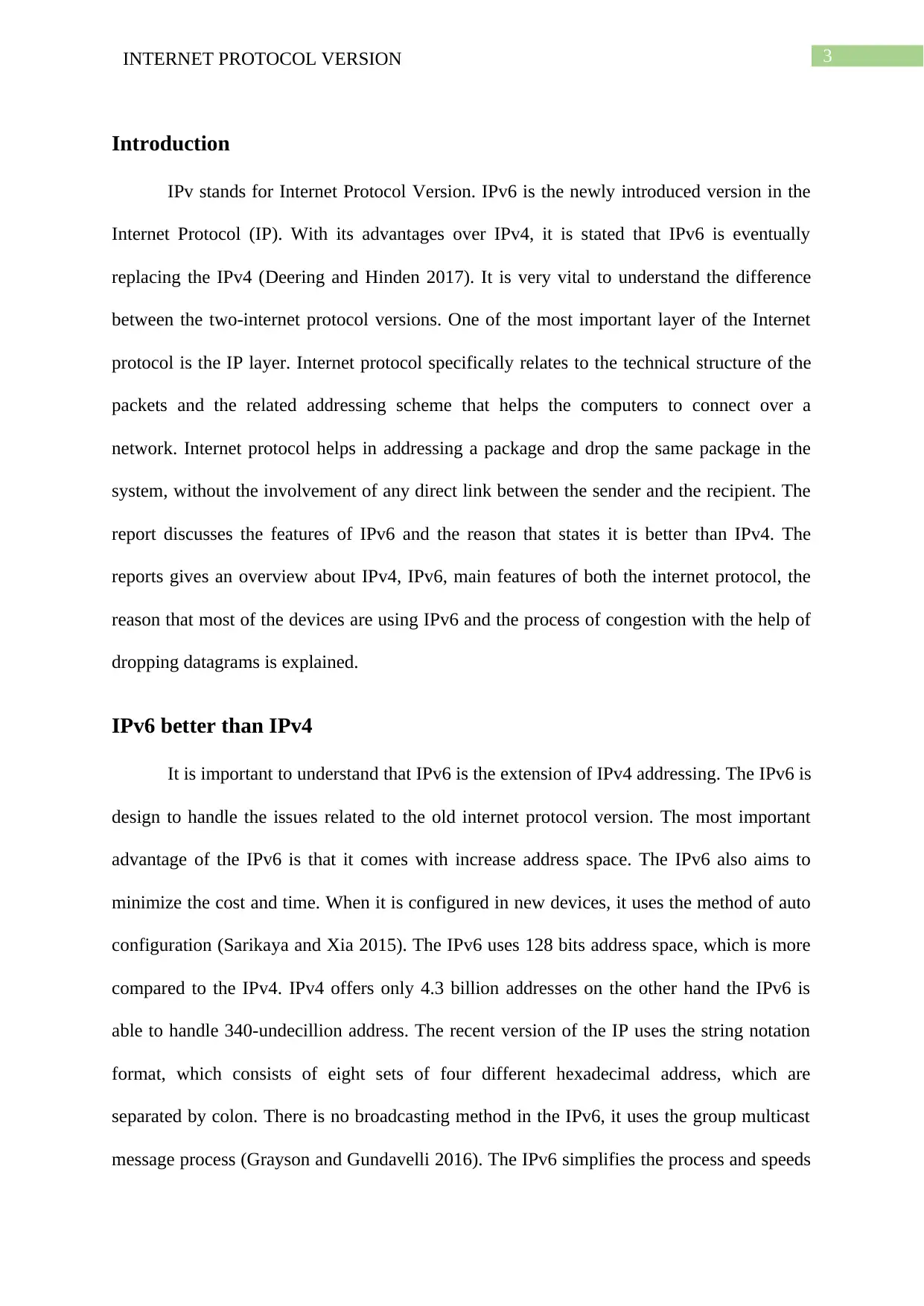
3INTERNET PROTOCOL VERSION
Introduction
IPv stands for Internet Protocol Version. IPv6 is the newly introduced version in the
Internet Protocol (IP). With its advantages over IPv4, it is stated that IPv6 is eventually
replacing the IPv4 (Deering and Hinden 2017). It is very vital to understand the difference
between the two-internet protocol versions. One of the most important layer of the Internet
protocol is the IP layer. Internet protocol specifically relates to the technical structure of the
packets and the related addressing scheme that helps the computers to connect over a
network. Internet protocol helps in addressing a package and drop the same package in the
system, without the involvement of any direct link between the sender and the recipient. The
report discusses the features of IPv6 and the reason that states it is better than IPv4. The
reports gives an overview about IPv4, IPv6, main features of both the internet protocol, the
reason that most of the devices are using IPv6 and the process of congestion with the help of
dropping datagrams is explained.
IPv6 better than IPv4
It is important to understand that IPv6 is the extension of IPv4 addressing. The IPv6 is
design to handle the issues related to the old internet protocol version. The most important
advantage of the IPv6 is that it comes with increase address space. The IPv6 also aims to
minimize the cost and time. When it is configured in new devices, it uses the method of auto
configuration (Sarikaya and Xia 2015). The IPv6 uses 128 bits address space, which is more
compared to the IPv4. IPv4 offers only 4.3 billion addresses on the other hand the IPv6 is
able to handle 340-undecillion address. The recent version of the IP uses the string notation
format, which consists of eight sets of four different hexadecimal address, which are
separated by colon. There is no broadcasting method in the IPv6, it uses the group multicast
message process (Grayson and Gundavelli 2016). The IPv6 simplifies the process and speeds
Introduction
IPv stands for Internet Protocol Version. IPv6 is the newly introduced version in the
Internet Protocol (IP). With its advantages over IPv4, it is stated that IPv6 is eventually
replacing the IPv4 (Deering and Hinden 2017). It is very vital to understand the difference
between the two-internet protocol versions. One of the most important layer of the Internet
protocol is the IP layer. Internet protocol specifically relates to the technical structure of the
packets and the related addressing scheme that helps the computers to connect over a
network. Internet protocol helps in addressing a package and drop the same package in the
system, without the involvement of any direct link between the sender and the recipient. The
report discusses the features of IPv6 and the reason that states it is better than IPv4. The
reports gives an overview about IPv4, IPv6, main features of both the internet protocol, the
reason that most of the devices are using IPv6 and the process of congestion with the help of
dropping datagrams is explained.
IPv6 better than IPv4
It is important to understand that IPv6 is the extension of IPv4 addressing. The IPv6 is
design to handle the issues related to the old internet protocol version. The most important
advantage of the IPv6 is that it comes with increase address space. The IPv6 also aims to
minimize the cost and time. When it is configured in new devices, it uses the method of auto
configuration (Sarikaya and Xia 2015). The IPv6 uses 128 bits address space, which is more
compared to the IPv4. IPv4 offers only 4.3 billion addresses on the other hand the IPv6 is
able to handle 340-undecillion address. The recent version of the IP uses the string notation
format, which consists of eight sets of four different hexadecimal address, which are
separated by colon. There is no broadcasting method in the IPv6, it uses the group multicast
message process (Grayson and Gundavelli 2016). The IPv6 simplifies the process and speeds
Paraphrase This Document
Need a fresh take? Get an instant paraphrase of this document with our AI Paraphraser
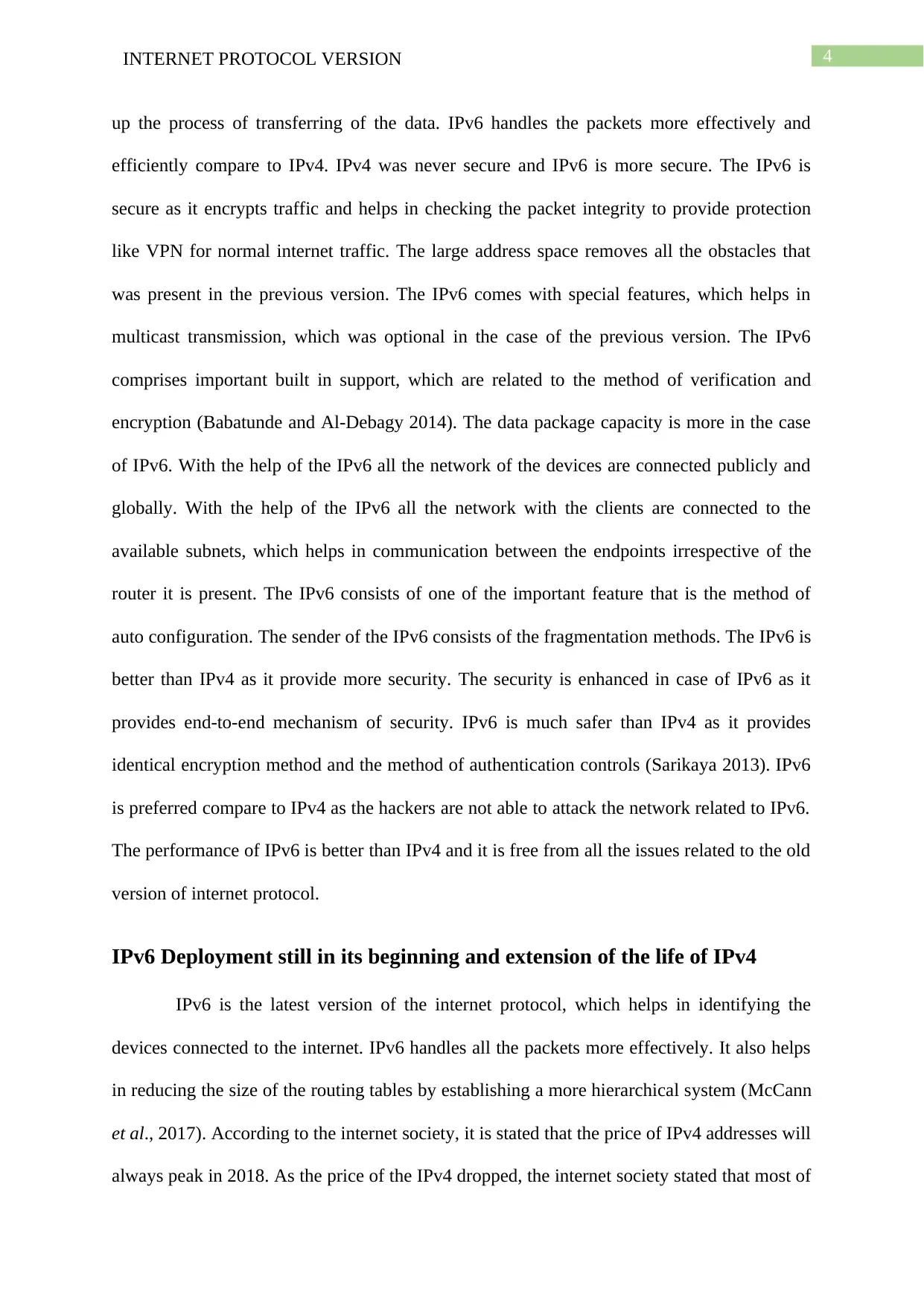
4INTERNET PROTOCOL VERSION
up the process of transferring of the data. IPv6 handles the packets more effectively and
efficiently compare to IPv4. IPv4 was never secure and IPv6 is more secure. The IPv6 is
secure as it encrypts traffic and helps in checking the packet integrity to provide protection
like VPN for normal internet traffic. The large address space removes all the obstacles that
was present in the previous version. The IPv6 comes with special features, which helps in
multicast transmission, which was optional in the case of the previous version. The IPv6
comprises important built in support, which are related to the method of verification and
encryption (Babatunde and Al-Debagy 2014). The data package capacity is more in the case
of IPv6. With the help of the IPv6 all the network of the devices are connected publicly and
globally. With the help of the IPv6 all the network with the clients are connected to the
available subnets, which helps in communication between the endpoints irrespective of the
router it is present. The IPv6 consists of one of the important feature that is the method of
auto configuration. The sender of the IPv6 consists of the fragmentation methods. The IPv6 is
better than IPv4 as it provide more security. The security is enhanced in case of IPv6 as it
provides end-to-end mechanism of security. IPv6 is much safer than IPv4 as it provides
identical encryption method and the method of authentication controls (Sarikaya 2013). IPv6
is preferred compare to IPv4 as the hackers are not able to attack the network related to IPv6.
The performance of IPv6 is better than IPv4 and it is free from all the issues related to the old
version of internet protocol.
IPv6 Deployment still in its beginning and extension of the life of IPv4
IPv6 is the latest version of the internet protocol, which helps in identifying the
devices connected to the internet. IPv6 handles all the packets more effectively. It also helps
in reducing the size of the routing tables by establishing a more hierarchical system (McCann
et al., 2017). According to the internet society, it is stated that the price of IPv4 addresses will
always peak in 2018. As the price of the IPv4 dropped, the internet society stated that most of
up the process of transferring of the data. IPv6 handles the packets more effectively and
efficiently compare to IPv4. IPv4 was never secure and IPv6 is more secure. The IPv6 is
secure as it encrypts traffic and helps in checking the packet integrity to provide protection
like VPN for normal internet traffic. The large address space removes all the obstacles that
was present in the previous version. The IPv6 comes with special features, which helps in
multicast transmission, which was optional in the case of the previous version. The IPv6
comprises important built in support, which are related to the method of verification and
encryption (Babatunde and Al-Debagy 2014). The data package capacity is more in the case
of IPv6. With the help of the IPv6 all the network of the devices are connected publicly and
globally. With the help of the IPv6 all the network with the clients are connected to the
available subnets, which helps in communication between the endpoints irrespective of the
router it is present. The IPv6 consists of one of the important feature that is the method of
auto configuration. The sender of the IPv6 consists of the fragmentation methods. The IPv6 is
better than IPv4 as it provide more security. The security is enhanced in case of IPv6 as it
provides end-to-end mechanism of security. IPv6 is much safer than IPv4 as it provides
identical encryption method and the method of authentication controls (Sarikaya 2013). IPv6
is preferred compare to IPv4 as the hackers are not able to attack the network related to IPv6.
The performance of IPv6 is better than IPv4 and it is free from all the issues related to the old
version of internet protocol.
IPv6 Deployment still in its beginning and extension of the life of IPv4
IPv6 is the latest version of the internet protocol, which helps in identifying the
devices connected to the internet. IPv6 handles all the packets more effectively. It also helps
in reducing the size of the routing tables by establishing a more hierarchical system (McCann
et al., 2017). According to the internet society, it is stated that the price of IPv4 addresses will
always peak in 2018. As the price of the IPv4 dropped, the internet society stated that most of
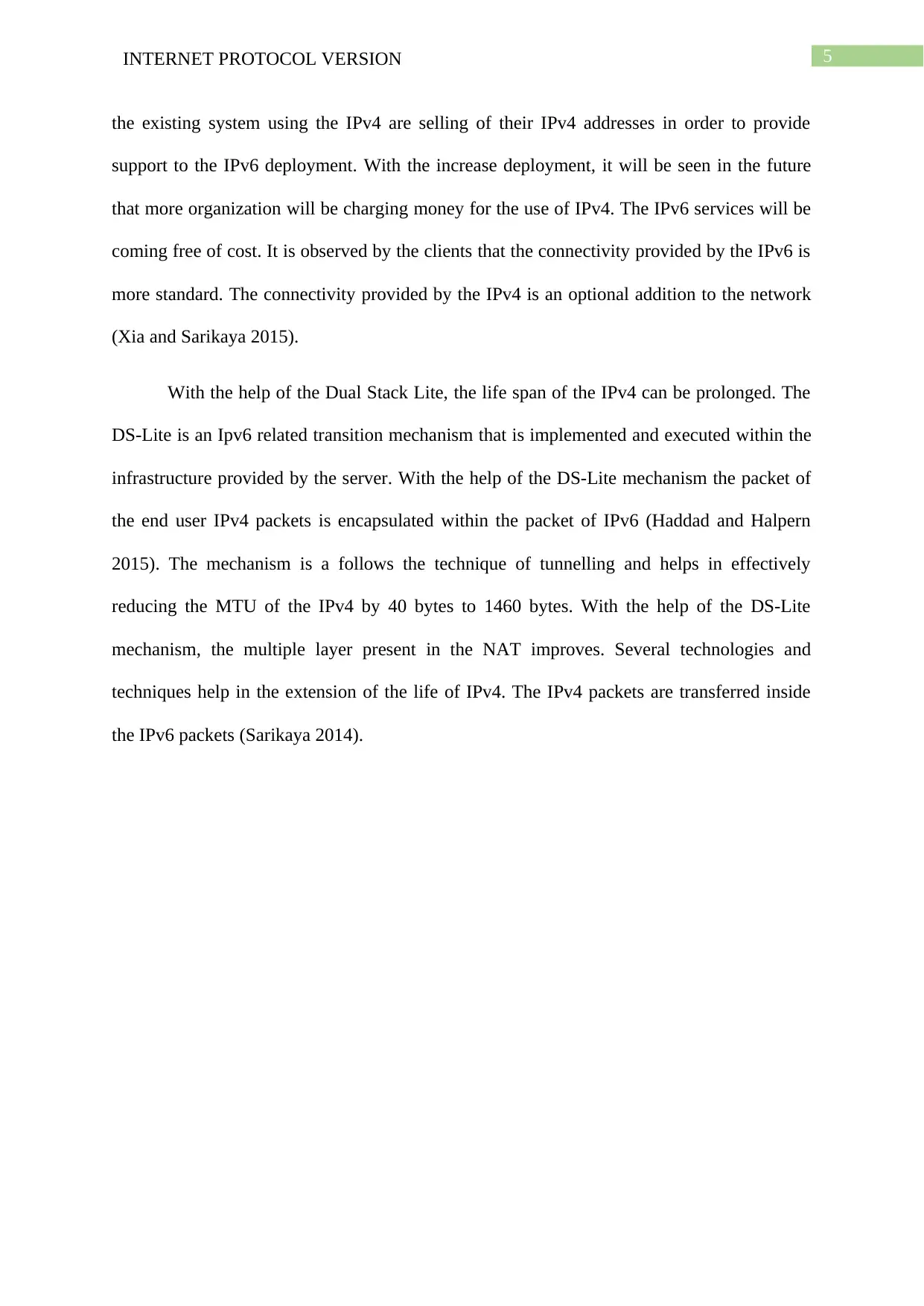
5INTERNET PROTOCOL VERSION
the existing system using the IPv4 are selling of their IPv4 addresses in order to provide
support to the IPv6 deployment. With the increase deployment, it will be seen in the future
that more organization will be charging money for the use of IPv4. The IPv6 services will be
coming free of cost. It is observed by the clients that the connectivity provided by the IPv6 is
more standard. The connectivity provided by the IPv4 is an optional addition to the network
(Xia and Sarikaya 2015).
With the help of the Dual Stack Lite, the life span of the IPv4 can be prolonged. The
DS-Lite is an Ipv6 related transition mechanism that is implemented and executed within the
infrastructure provided by the server. With the help of the DS-Lite mechanism the packet of
the end user IPv4 packets is encapsulated within the packet of IPv6 (Haddad and Halpern
2015). The mechanism is a follows the technique of tunnelling and helps in effectively
reducing the MTU of the IPv4 by 40 bytes to 1460 bytes. With the help of the DS-Lite
mechanism, the multiple layer present in the NAT improves. Several technologies and
techniques help in the extension of the life of IPv4. The IPv4 packets are transferred inside
the IPv6 packets (Sarikaya 2014).
the existing system using the IPv4 are selling of their IPv4 addresses in order to provide
support to the IPv6 deployment. With the increase deployment, it will be seen in the future
that more organization will be charging money for the use of IPv4. The IPv6 services will be
coming free of cost. It is observed by the clients that the connectivity provided by the IPv6 is
more standard. The connectivity provided by the IPv4 is an optional addition to the network
(Xia and Sarikaya 2015).
With the help of the Dual Stack Lite, the life span of the IPv4 can be prolonged. The
DS-Lite is an Ipv6 related transition mechanism that is implemented and executed within the
infrastructure provided by the server. With the help of the DS-Lite mechanism the packet of
the end user IPv4 packets is encapsulated within the packet of IPv6 (Haddad and Halpern
2015). The mechanism is a follows the technique of tunnelling and helps in effectively
reducing the MTU of the IPv4 by 40 bytes to 1460 bytes. With the help of the DS-Lite
mechanism, the multiple layer present in the NAT improves. Several technologies and
techniques help in the extension of the life of IPv4. The IPv4 packets are transferred inside
the IPv6 packets (Sarikaya 2014).
⊘ This is a preview!⊘
Do you want full access?
Subscribe today to unlock all pages.

Trusted by 1+ million students worldwide
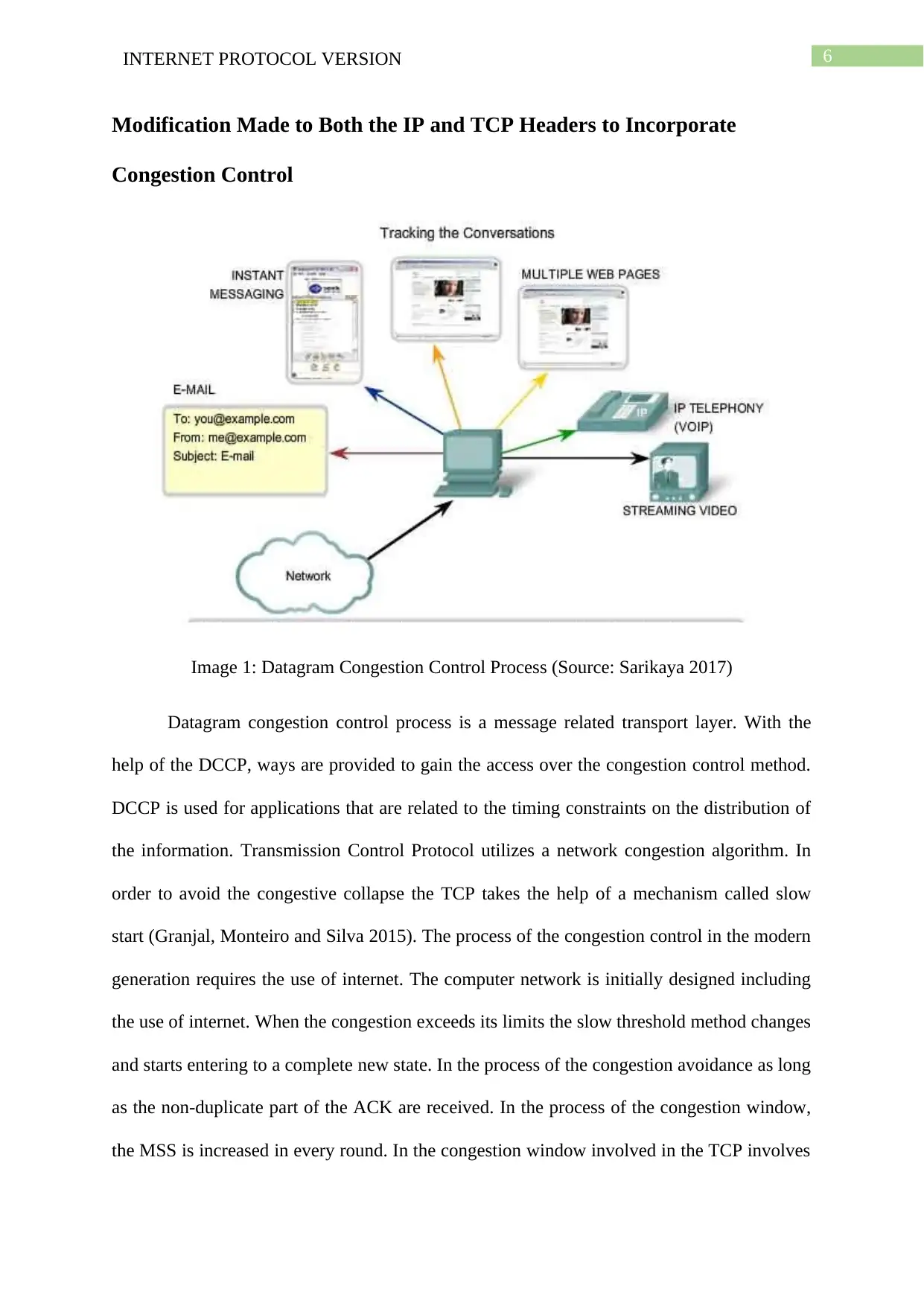
6INTERNET PROTOCOL VERSION
Modification Made to Both the IP and TCP Headers to Incorporate
Congestion Control
Image 1: Datagram Congestion Control Process (Source: Sarikaya 2017)
Datagram congestion control process is a message related transport layer. With the
help of the DCCP, ways are provided to gain the access over the congestion control method.
DCCP is used for applications that are related to the timing constraints on the distribution of
the information. Transmission Control Protocol utilizes a network congestion algorithm. In
order to avoid the congestive collapse the TCP takes the help of a mechanism called slow
start (Granjal, Monteiro and Silva 2015). The process of the congestion control in the modern
generation requires the use of internet. The computer network is initially designed including
the use of internet. When the congestion exceeds its limits the slow threshold method changes
and starts entering to a complete new state. In the process of the congestion avoidance as long
as the non-duplicate part of the ACK are received. In the process of the congestion window,
the MSS is increased in every round. In the congestion window involved in the TCP involves
Modification Made to Both the IP and TCP Headers to Incorporate
Congestion Control
Image 1: Datagram Congestion Control Process (Source: Sarikaya 2017)
Datagram congestion control process is a message related transport layer. With the
help of the DCCP, ways are provided to gain the access over the congestion control method.
DCCP is used for applications that are related to the timing constraints on the distribution of
the information. Transmission Control Protocol utilizes a network congestion algorithm. In
order to avoid the congestive collapse the TCP takes the help of a mechanism called slow
start (Granjal, Monteiro and Silva 2015). The process of the congestion control in the modern
generation requires the use of internet. The computer network is initially designed including
the use of internet. When the congestion exceeds its limits the slow threshold method changes
and starts entering to a complete new state. In the process of the congestion avoidance as long
as the non-duplicate part of the ACK are received. In the process of the congestion window,
the MSS is increased in every round. In the congestion window involved in the TCP involves
Paraphrase This Document
Need a fresh take? Get an instant paraphrase of this document with our AI Paraphraser
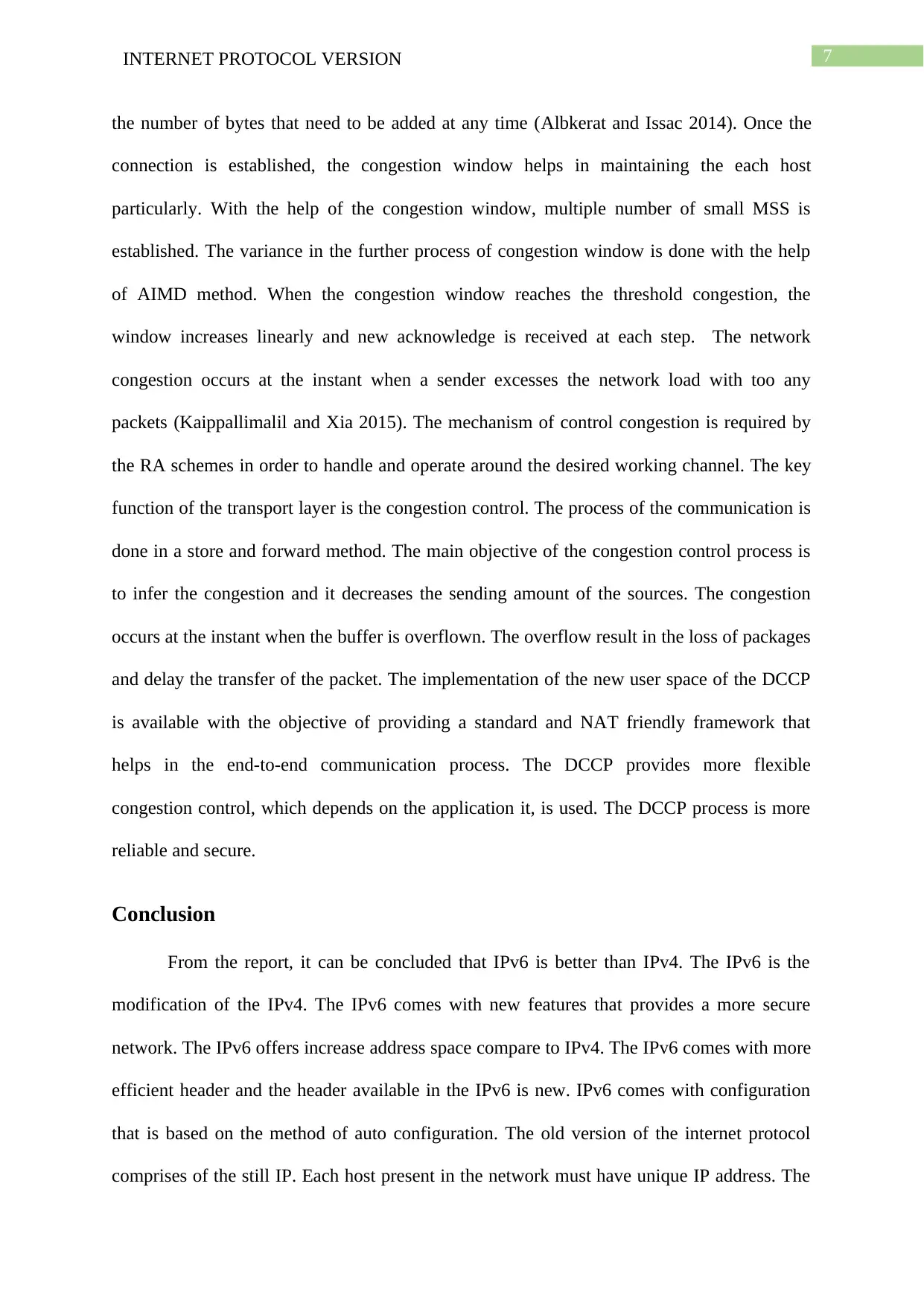
7INTERNET PROTOCOL VERSION
the number of bytes that need to be added at any time (Albkerat and Issac 2014). Once the
connection is established, the congestion window helps in maintaining the each host
particularly. With the help of the congestion window, multiple number of small MSS is
established. The variance in the further process of congestion window is done with the help
of AIMD method. When the congestion window reaches the threshold congestion, the
window increases linearly and new acknowledge is received at each step. The network
congestion occurs at the instant when a sender excesses the network load with too any
packets (Kaippallimalil and Xia 2015). The mechanism of control congestion is required by
the RA schemes in order to handle and operate around the desired working channel. The key
function of the transport layer is the congestion control. The process of the communication is
done in a store and forward method. The main objective of the congestion control process is
to infer the congestion and it decreases the sending amount of the sources. The congestion
occurs at the instant when the buffer is overflown. The overflow result in the loss of packages
and delay the transfer of the packet. The implementation of the new user space of the DCCP
is available with the objective of providing a standard and NAT friendly framework that
helps in the end-to-end communication process. The DCCP provides more flexible
congestion control, which depends on the application it, is used. The DCCP process is more
reliable and secure.
Conclusion
From the report, it can be concluded that IPv6 is better than IPv4. The IPv6 is the
modification of the IPv4. The IPv6 comes with new features that provides a more secure
network. The IPv6 offers increase address space compare to IPv4. The IPv6 comes with more
efficient header and the header available in the IPv6 is new. IPv6 comes with configuration
that is based on the method of auto configuration. The old version of the internet protocol
comprises of the still IP. Each host present in the network must have unique IP address. The
the number of bytes that need to be added at any time (Albkerat and Issac 2014). Once the
connection is established, the congestion window helps in maintaining the each host
particularly. With the help of the congestion window, multiple number of small MSS is
established. The variance in the further process of congestion window is done with the help
of AIMD method. When the congestion window reaches the threshold congestion, the
window increases linearly and new acknowledge is received at each step. The network
congestion occurs at the instant when a sender excesses the network load with too any
packets (Kaippallimalil and Xia 2015). The mechanism of control congestion is required by
the RA schemes in order to handle and operate around the desired working channel. The key
function of the transport layer is the congestion control. The process of the communication is
done in a store and forward method. The main objective of the congestion control process is
to infer the congestion and it decreases the sending amount of the sources. The congestion
occurs at the instant when the buffer is overflown. The overflow result in the loss of packages
and delay the transfer of the packet. The implementation of the new user space of the DCCP
is available with the objective of providing a standard and NAT friendly framework that
helps in the end-to-end communication process. The DCCP provides more flexible
congestion control, which depends on the application it, is used. The DCCP process is more
reliable and secure.
Conclusion
From the report, it can be concluded that IPv6 is better than IPv4. The IPv6 is the
modification of the IPv4. The IPv6 comes with new features that provides a more secure
network. The IPv6 offers increase address space compare to IPv4. The IPv6 comes with more
efficient header and the header available in the IPv6 is new. IPv6 comes with configuration
that is based on the method of auto configuration. The old version of the internet protocol
comprises of the still IP. Each host present in the network must have unique IP address. The

8INTERNET PROTOCOL VERSION
most important layer of the internet protocol is the IP layer. IPv6 is the extension version of
the IPv4. IPv6 is more secure and provides security more compare to the IPv4. The IPv6
provides DHCP port support and helps to connect with the network in a more secure way.
However, it can be stated that IPv6 comes with more unique features, is more stable and
secure compare to the old version of the IP.
most important layer of the internet protocol is the IP layer. IPv6 is the extension version of
the IPv4. IPv6 is more secure and provides security more compare to the IPv4. The IPv6
provides DHCP port support and helps to connect with the network in a more secure way.
However, it can be stated that IPv6 comes with more unique features, is more stable and
secure compare to the old version of the IP.
⊘ This is a preview!⊘
Do you want full access?
Subscribe today to unlock all pages.

Trusted by 1+ million students worldwide
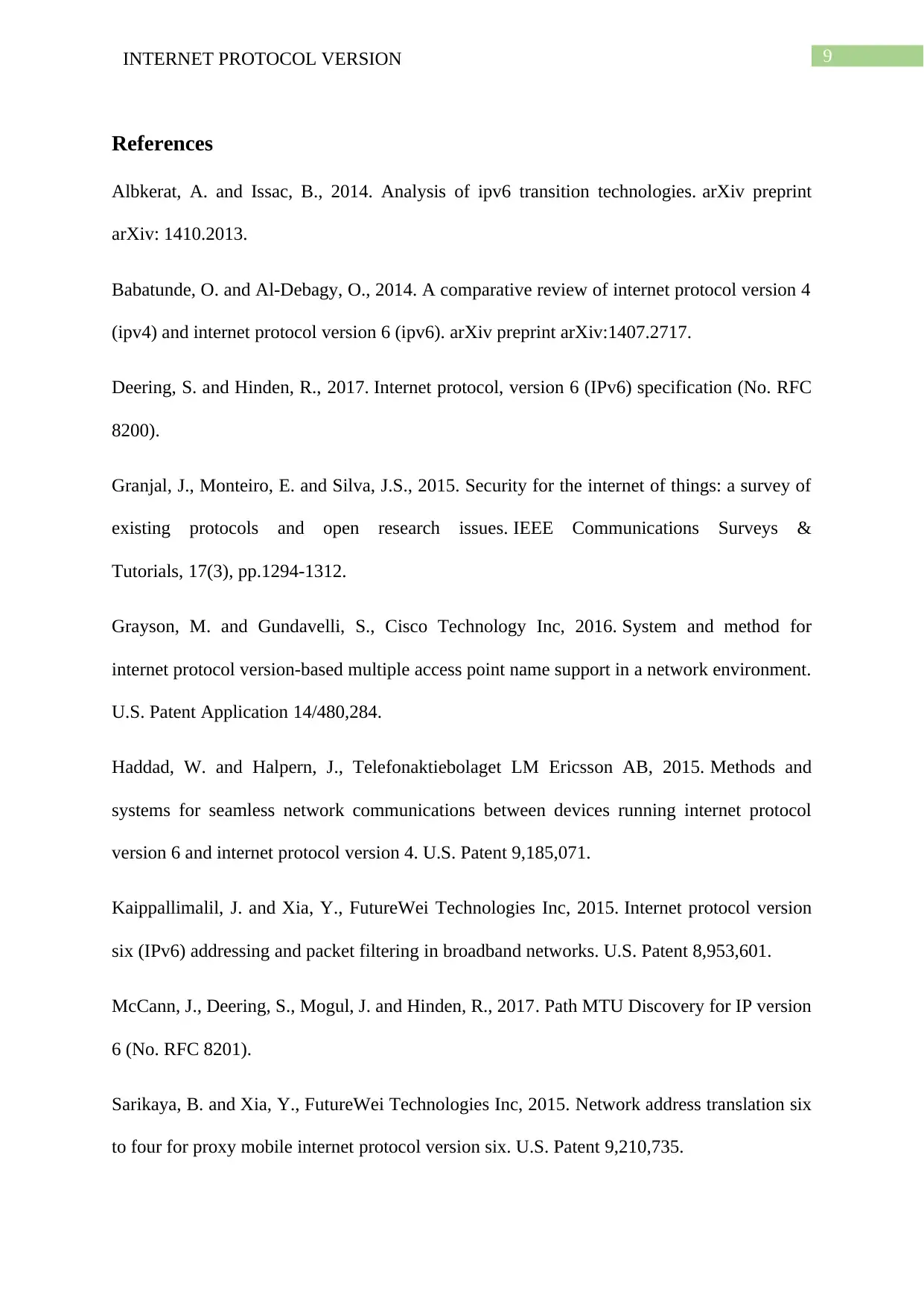
9INTERNET PROTOCOL VERSION
References
Albkerat, A. and Issac, B., 2014. Analysis of ipv6 transition technologies. arXiv preprint
arXiv: 1410.2013.
Babatunde, O. and Al-Debagy, O., 2014. A comparative review of internet protocol version 4
(ipv4) and internet protocol version 6 (ipv6). arXiv preprint arXiv:1407.2717.
Deering, S. and Hinden, R., 2017. Internet protocol, version 6 (IPv6) specification (No. RFC
8200).
Granjal, J., Monteiro, E. and Silva, J.S., 2015. Security for the internet of things: a survey of
existing protocols and open research issues. IEEE Communications Surveys &
Tutorials, 17(3), pp.1294-1312.
Grayson, M. and Gundavelli, S., Cisco Technology Inc, 2016. System and method for
internet protocol version-based multiple access point name support in a network environment.
U.S. Patent Application 14/480,284.
Haddad, W. and Halpern, J., Telefonaktiebolaget LM Ericsson AB, 2015. Methods and
systems for seamless network communications between devices running internet protocol
version 6 and internet protocol version 4. U.S. Patent 9,185,071.
Kaippallimalil, J. and Xia, Y., FutureWei Technologies Inc, 2015. Internet protocol version
six (IPv6) addressing and packet filtering in broadband networks. U.S. Patent 8,953,601.
McCann, J., Deering, S., Mogul, J. and Hinden, R., 2017. Path MTU Discovery for IP version
6 (No. RFC 8201).
Sarikaya, B. and Xia, Y., FutureWei Technologies Inc, 2015. Network address translation six
to four for proxy mobile internet protocol version six. U.S. Patent 9,210,735.
References
Albkerat, A. and Issac, B., 2014. Analysis of ipv6 transition technologies. arXiv preprint
arXiv: 1410.2013.
Babatunde, O. and Al-Debagy, O., 2014. A comparative review of internet protocol version 4
(ipv4) and internet protocol version 6 (ipv6). arXiv preprint arXiv:1407.2717.
Deering, S. and Hinden, R., 2017. Internet protocol, version 6 (IPv6) specification (No. RFC
8200).
Granjal, J., Monteiro, E. and Silva, J.S., 2015. Security for the internet of things: a survey of
existing protocols and open research issues. IEEE Communications Surveys &
Tutorials, 17(3), pp.1294-1312.
Grayson, M. and Gundavelli, S., Cisco Technology Inc, 2016. System and method for
internet protocol version-based multiple access point name support in a network environment.
U.S. Patent Application 14/480,284.
Haddad, W. and Halpern, J., Telefonaktiebolaget LM Ericsson AB, 2015. Methods and
systems for seamless network communications between devices running internet protocol
version 6 and internet protocol version 4. U.S. Patent 9,185,071.
Kaippallimalil, J. and Xia, Y., FutureWei Technologies Inc, 2015. Internet protocol version
six (IPv6) addressing and packet filtering in broadband networks. U.S. Patent 8,953,601.
McCann, J., Deering, S., Mogul, J. and Hinden, R., 2017. Path MTU Discovery for IP version
6 (No. RFC 8201).
Sarikaya, B. and Xia, Y., FutureWei Technologies Inc, 2015. Network address translation six
to four for proxy mobile internet protocol version six. U.S. Patent 9,210,735.
Paraphrase This Document
Need a fresh take? Get an instant paraphrase of this document with our AI Paraphraser
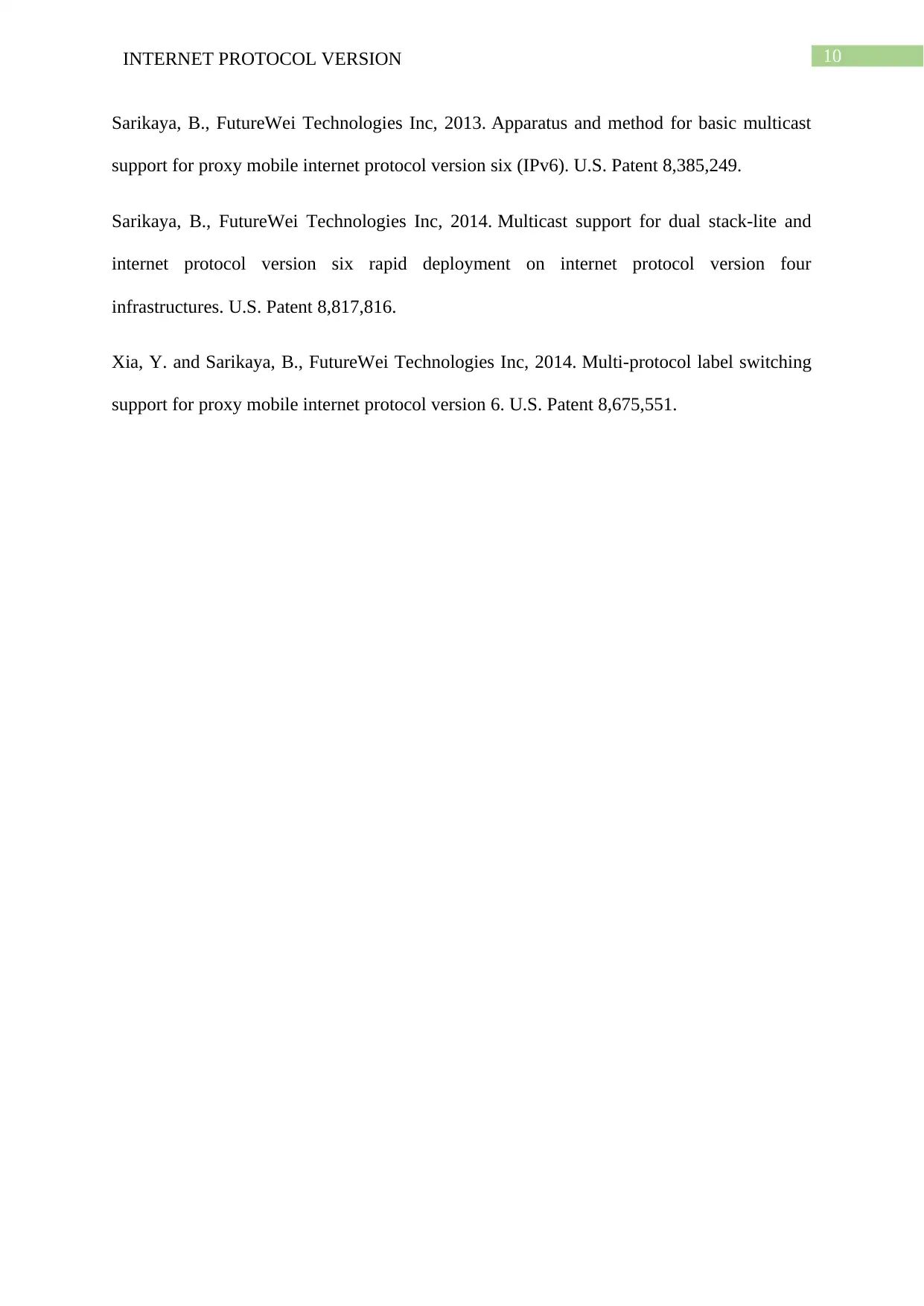
10INTERNET PROTOCOL VERSION
Sarikaya, B., FutureWei Technologies Inc, 2013. Apparatus and method for basic multicast
support for proxy mobile internet protocol version six (IPv6). U.S. Patent 8,385,249.
Sarikaya, B., FutureWei Technologies Inc, 2014. Multicast support for dual stack-lite and
internet protocol version six rapid deployment on internet protocol version four
infrastructures. U.S. Patent 8,817,816.
Xia, Y. and Sarikaya, B., FutureWei Technologies Inc, 2014. Multi-protocol label switching
support for proxy mobile internet protocol version 6. U.S. Patent 8,675,551.
Sarikaya, B., FutureWei Technologies Inc, 2013. Apparatus and method for basic multicast
support for proxy mobile internet protocol version six (IPv6). U.S. Patent 8,385,249.
Sarikaya, B., FutureWei Technologies Inc, 2014. Multicast support for dual stack-lite and
internet protocol version six rapid deployment on internet protocol version four
infrastructures. U.S. Patent 8,817,816.
Xia, Y. and Sarikaya, B., FutureWei Technologies Inc, 2014. Multi-protocol label switching
support for proxy mobile internet protocol version 6. U.S. Patent 8,675,551.
1 out of 11
Related Documents
Your All-in-One AI-Powered Toolkit for Academic Success.
+13062052269
info@desklib.com
Available 24*7 on WhatsApp / Email
![[object Object]](/_next/static/media/star-bottom.7253800d.svg)
Unlock your academic potential
Copyright © 2020–2025 A2Z Services. All Rights Reserved. Developed and managed by ZUCOL.

